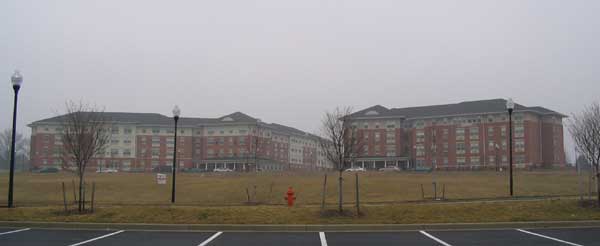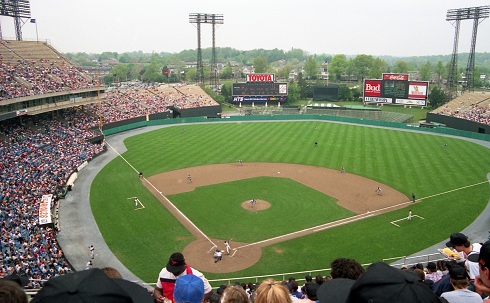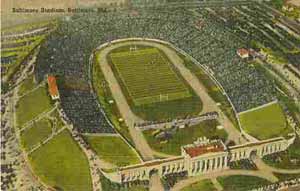
Current day site.
|
Memorial Stadium | |||||||
|
Baltimore, MD
Please note: As I have mentioned before, instead of getting silly with parks, I only count a park once per site. There were two parks at Venable Park, but since it is only one site, I only count it once. I have broken down each site below.
| Team: Baltimore Orioles | Opening Day: April 15, 1954 |
| Capacity: 53,371 (1991) | Dimensions: LF 309, CF 405, RF 309 |
| Surface: Bluegrass | Architect: L.P. Kooken Company |
| Cost: $6.5 Million | Closing Day: September 30, 1991 |
| Demolished: April 21, 2001 | Owner: City of Baltimore |
| Contractor: DeLucca-Davis and Joseph F. Hughes companies | Minor League Use: 1950 - 1953 |

Current day site.
Memorable Moments:

I went to this stadium a long time ago so I can't give an accurate description. I went with my Uncle who lives in Maryland to watch the O's play the Red Sox (me being from Boston). Anyway, everyone around us was very much a Sox fan and very much drunk. A very colorful moment of my youth.
Inscribed into the concrete facade: "Dedicated as a memorial to all who so valiantly fought in the world wars with eternal gratitude to those who made the supreme sacrifice to preserve equality and freedom throughout the world -time will not dim the glory of their deeds."
The Baltimore Orioles, originally a minor league team, moved into Memorial Stadium when Oriole Park burned down. The NFL Colts were also playing here. The Stadium then sat 31,000. In 1954, the city expanded the stadium in order to lure the Saint Louis Browns to Baltimore and the major league Orioles were born (again, the first team turned into the Yankees in 1901).
The Orioles retired numbers are (in numerical order):

This story was contributed by Michael R. Conner. He worked for the Orioles at Memorial Stadium for 15 seasons.
I have a particular memory of Memorial Stadium that is uniquely mine. I used to work for a while as an usher behind the visitors' dugout, which would be section 39. From our viewpoint, one could look straight down the left field line into the 309 corner. The right field corner was always hidden from us, but there were some crazy caroms as would-be doubles turned into triples when the ball would strike the angled doorway. It was behind this where the grounds crew kept supplies such as sand for rain-soaked mounds.
My memory was of the night where I worked the final game of the 1979 World Series between the Orioles and he Pittsburgh Pirates. After Stargell's homer, the fans sensed doom. You could read it on their faces. When the Pirates scored in the ninth, there was a mass exodus like I've never seen. Pirate wives were standing in the aisle and black-and-gold was pervasive. My instructions were not to allow anyone onto the dugout or onto the field after the completion of the game. When the Orioles' Pat Kelly flew out, the Pittsburgh crowd erupted and wives, friends and Pirate fans stood en masse on the dugout. These concrete structures had no support beams and I began to panic. Shouting to be heard, I implored the fans to get off the dugout. A Pirate wife, Mrs. Moreno I believe, said to me, "Don't worry, honey. We got lots of insurance."
Leaving them to their celebration, I retreated into the cavernous underground of the stadium. There was a labyrinth of passages, some leading to the clubhouses, some to Oriole offices. I passed a delirious Kent Tekulve, who had quaffed a split of celebratory Champagne, when the networks had sent someone to interview him. A couple of Pirate office personnel had his arms around their necks as they escorted/dragged him to the awaiting TV audience. He seemed barely able to utter monosyllabic responses. How he carried it off for TV is a wonderment to me.
Going back to the break room to return my uniform, I encountered a beaming man dressed in a Pirate uniform. He turned around to pat some of the celebrating pitchers on the back (It had spilled into our room by this time.) and I saw the name Haddix. He turned and beheld me, his countenance radiant and a hint of moisture in his eyes. I said congratulations to him. He shook my hand vigorously and said, "Thank you so much. Oh, what a thrill." I asked him if the 12 inning perfect game might have topped this. He said, "Oh no. This was so much better. These were my guys." I had forgotten that he was the pitching coach.
Municipal Stadium
| Teams: Baltimore Elite Giants (NNL2 1944 - 1948, NAL 1949 - 1950) | Opening Day: December 2, 1922 (for football) |
| Capacity: 52,833 | Dimensions: LF 290 |
| Closing Day: 1949 | AKA: Venable Stadium, Baltimore Stadium, Metropolitan Stadium, Babe Ruth Stadium |

Memorable Moments:
In 1922, Baltimore Mayor William Broening, requested that a stadium be built for the City of Baltimore to host college football games and possibly a major league franchise. It was built. On December 2, 1922, a football game between the Army 3rd Corps Area and Quantico Marines was held and witnessed by 43,000.
When Oriole Park V burned down on July 4, 1944, the Orioles need a new home and fast. They set up a diamond within the oval. This setup was similar to that of the Los Angeles Coliseum, with the short porch in left. Routinely, the Orioles would get between 20,000 to 40,000 for a baseball game. In fact, Clark Griffith, owner of the Washington Senators called the Orioles to confirm these numbers that he read in the newspaper.
Due to many spectators complaining about hot sun or extreme rain, they wanted seats that were covered. No one could see covering an old, rundown stadium, so Municipal Stadium was torn down and replaced with Memorial Stadium.
© 2001-17 Paul Healey. Photographs of the old stadium © their owners. Used without permission.